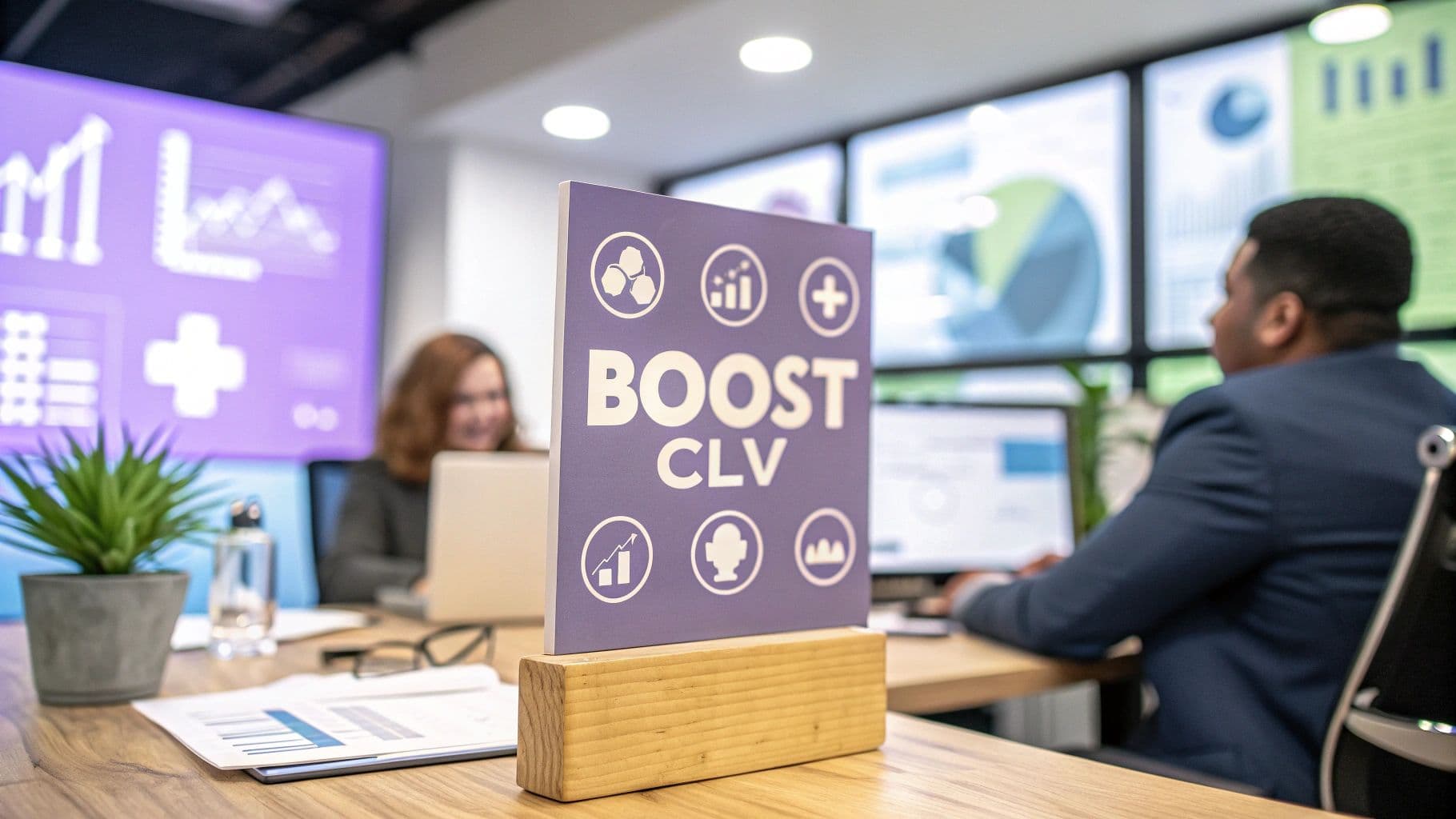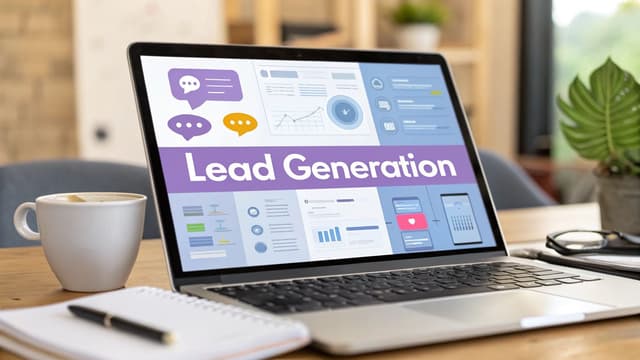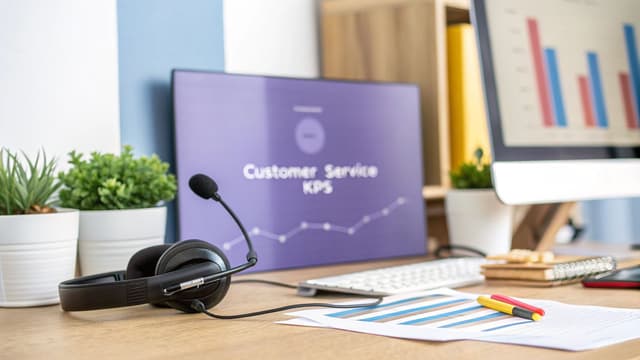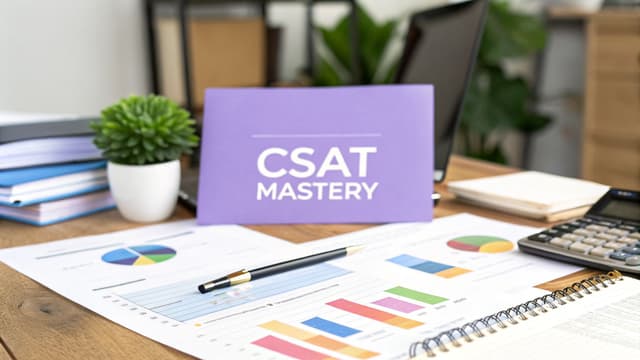When we talk about increasing customer lifetime value, what we're really talking about is a simple, powerful idea: making your existing customers so happy they want to stick around. It’s all about nailing the onboarding, delivering support that wows them, personalizing their journey, and building real loyalty. Do that, and you turn one-time buyers into genuine, long-term partners.
Why CLV Is Your Most Important Growth Metric
Let's be real—the constant chase for new customers is both exhausting and incredibly expensive. Landing new accounts feels like progress, but it’s often a treadmill of high acquisition costs and fleeting returns.
Sustainable, healthy business growth isn't just about how many new leads you can pull in. It's about how much value you create for the customers you already have. This is where Customer Lifetime Value (CLV) completely changes the game.
CLV is more than a metric; it's a mindset shift. It pulls your focus away from short-term sales and onto long-term relationships. You start thinking about the entire customer journey, not just that first conversion. When CLV becomes your north star, you're not just chasing dollars—you're building a business that can actually last.
The Real Cost of Neglecting Retention
It’s a classic trap: businesses pour the lion's share of their budget into customer acquisition while retention efforts get whatever’s left over. The data, however, paints a very different picture.
A tiny 5% bump in customer retention can boost your profitability by a jaw-dropping 25% to 95%. That's not a typo. This is even more critical when you realize that getting new customers in the door has become wildly expensive, with costs jumping by 222% in the last eight years alone. If you're curious about the trends, there are some great customer lifetime value statistics that break it down.
But this isn't just about saving cash. Focusing on retention creates a positive feedback loop that strengthens your entire business:
- Predictable Revenue: Loyal customers give you a stable, forecastable income stream you can actually build on.
- Higher Profit Margins: Repeat buyers cost less to serve and are often happy to pay a bit more for a brand they trust.
- Invaluable Feedback: Your long-term customers are the best source of honest, actionable feedback for making your products and services better.
- Brand Advocacy: Happy customers become your best marketers, spreading the word far more effectively than any ad campaign could.
By obsessing over CLV, you stop playing the costly game of "leaky bucket" marketing—where you constantly spend to replace the customers you fail to keep—and start building a fortress of loyal advocates.
The Business Case for Focusing on CLV
The first step to transforming your growth strategy is truly understanding the financial argument for CLV. It reframes everyday activities—from a support ticket to a marketing email—as investments in long-term profitability, not just operational costs.
The table below connects the dots, showing how retention-focused activities directly link to core business outcomes.
The Business Case for Focusing on CLV
| Metric/Strategy | Potential Business Impact |
|---|---|
| Improved Onboarding | Reduces early churn and sets the foundation for a longer customer relationship, directly increasing average customer lifespan. |
| Personalized Marketing | Increases engagement and repeat purchases by showing customers you understand their needs, boosting average purchase value. |
| Proactive Customer Service | Turns potential problems into loyalty-building opportunities, strengthening retention and customer satisfaction score calculation. |
| Loyalty Programs | Incentivizes repeat business and increases purchase frequency, making each customer more valuable over time. |
At the end of the day, figuring out how to increase customer lifetime value is the same as figuring out how to build a healthier, more profitable business. It gives you a clear map for putting your resources where they’ll make the biggest impact, ensuring every decision you make contributes to lasting success.
Calculating Your Customer Lifetime Value
You can't improve what you don't measure. It's an old business cliché, but it’s true. While "customer lifetime value" might sound like some high-level metric only analytics departments worry about, it's actually pretty straightforward to calculate. Getting a real handle on this number is the very first step to growing it intentionally.
Think of it as telling a simple story about your customer relationships, but with numbers.
The Core CLV Formula
The most common way to calculate CLV gives you a powerful snapshot of your business's health. It really just boils down to multiplying how much a customer typically spends by how often they buy, and then by how long they stick around.
The standard formula looks like this: (Average Purchase Value x Purchase Frequency) x Average Customer Lifespan = CLV.
Let’s say a retail brand sees an average sale of $50. Their customers tend to buy three times a year, and the average relationship lasts for about two years. That gives you a CLV of $300. This simple figure is gold because it helps you tailor your marketing and service strategies effectively.
Let's quickly break down each piece of that puzzle.
- Average Purchase Value (APV): This is just the average amount a customer spends each time they check out. Find it by dividing your total revenue over a period (like a quarter or year) by the number of orders in that same timeframe.
- Purchase Frequency (PF): This tells you how often the average customer buys from you. Calculate it by dividing the total number of orders by the number of unique customers.
- Average Customer Lifespan (ACL): This is the average time a customer continues to buy from you. This one can be a bit trickier, but a simple way to start is by averaging the time between the first and last purchase for all your customers.
Once you have these three numbers, you can plug them into the formula to get a baseline CLV. For a more granular approach, you can explore a complete guide on how to calculate customer lifetime value.
Bringing the Numbers to Life
Let’s imagine you run a SaaS company with a subscription model. Your customers pay $99 per month (that's your APV). Since they're billed monthly, their purchase frequency is 12 times per year. After digging into your churn data, you find the average customer sticks around for 3.5 years (your ACL).
The math is simple: ($99 APV x 12 PF) x 3.5 years = $4,158 CLV.
That $4,158 is an incredibly powerful number. It tells you the total revenue you can reasonably expect from the average new subscriber. More importantly, it gives you a clear ceiling for your Customer Acquisition Cost (CAC), which is critical for ensuring your growth is actually profitable. If you need more ideas on keeping those customers around, check out our guide on effective customer retention strategies for 2025.
A good CRM dashboard will often visualize this for you, helping you see different value tiers at a glance.
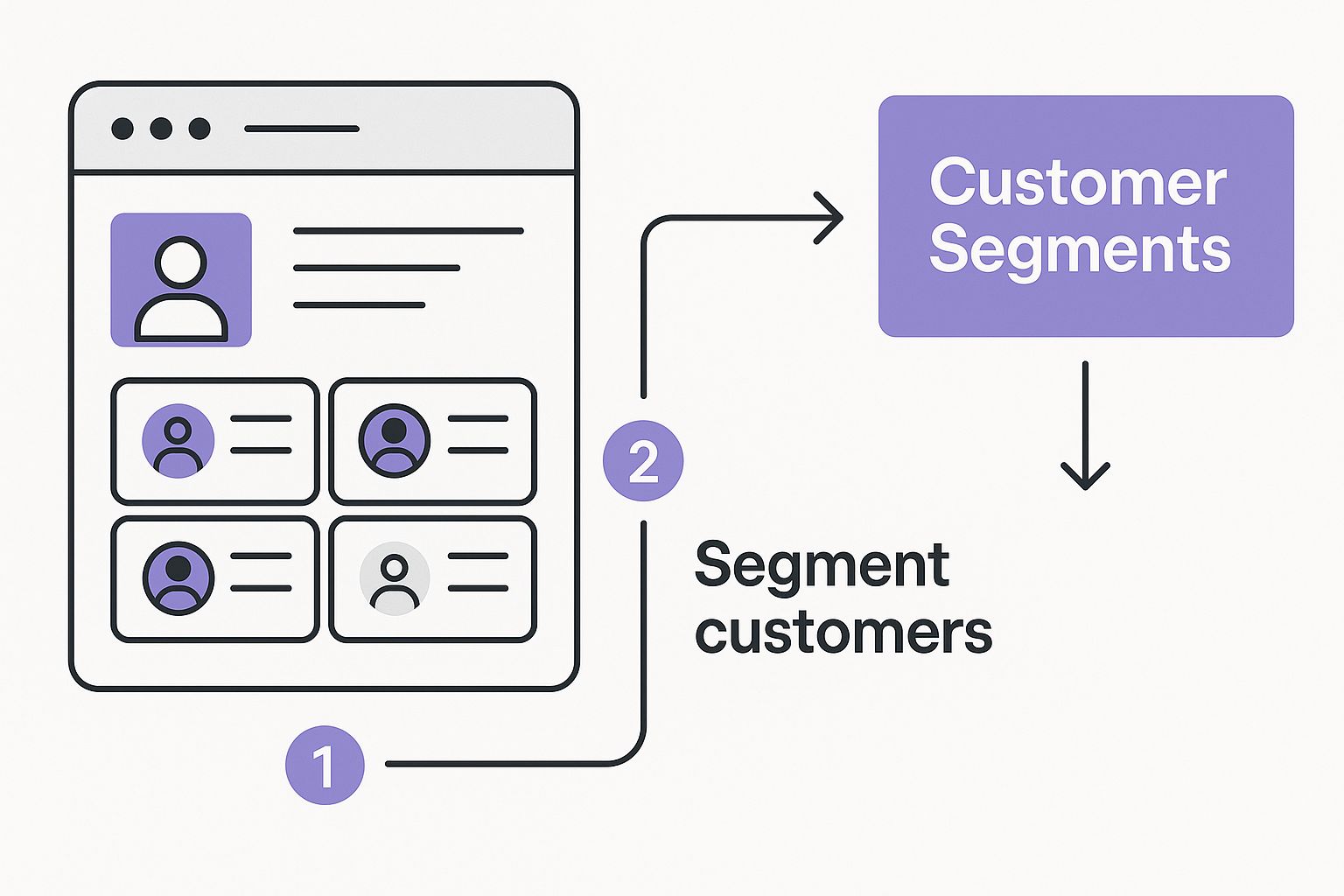
When you can see the data like this, you can quickly spot your high-value cohorts and figure out what makes them tick.
Key Takeaway: Calculating your CLV isn’t just an accounting task. It fundamentally shifts your perspective from focusing on the immediate transaction to the long-term health of your customer relationships.
Once you have this number in hand, the real work begins. You can start segmenting your customer base to identify not just who your most valuable customers are, but more importantly, why. This insight is the foundation for every strategy that follows.
Using the LTV to CAC Ratio for Smart Growth

Figuring out your Customer Lifetime Value is a massive win, but that number on its own is only half the story. To really put that knowledge to work, you need to see how it stacks up against another key metric: your Customer Acquisition Cost (CAC).
This is where the LTV to CAC ratio enters the picture. Think of it as the ultimate health check for your entire business model.
This simple ratio compares the total value a customer will bring you over time against what you spent to get them in the door. It’s your profitability compass. It tells you if your marketing budget is delivering a solid return or if you're just spinning your wheels acquiring customers who bail before you break even. It’s the key to making sure you’re not just growing, but growing profitably.
Decoding the Numbers
The LTV to CAC ratio is a straightforward comparison, but the insight it offers is anything but simple. It’s the number one indicator of whether your customer relationships are financially sustainable.
Most healthy businesses aim for a Lifetime Value to Customer Acquisition Cost (LTV:CAC) ratio of around 3:1. What does that mean? For every dollar you spend to land a new customer, you get three dollars back in value over their lifetime. It’s the sweet spot.
If your ratio is way below that, it’s a red flag that you’re paying too much for customers who don’t stick around. If it’s significantly higher, you might actually be underinvesting in growth and leaving money on the table. For a deeper dive, check out why client retention is so important for business in 2025.
When your LTV is triple your CAC, you've found a sustainable engine for growth. You have enough margin to cover your operational costs, reinvest in product development, and still turn a healthy profit.
Interpreting Your LTV to CAC Ratio
Understanding what your specific ratio means is the first step toward improving it. The goal isn't just to blindly chase a 3:1 ratio; it's to understand what your current number is telling you about your business.
To help you diagnose the health of your acquisition and retention efforts, here’s a quick-reference guide.
Interpreting Your LTV to CAC Ratio
This table breaks down what different ratios mean and what you should probably do about them.
| LTV:CAC Ratio | What It Means | Recommended Action |
|---|---|---|
| Below 1:1 | You're losing money on every customer. Your acquisition strategy is unsustainable. You're spending more to get them than they'll ever give back. | Immediately pause or drastically cut paid acquisition. Go all-in on improving product value and retention to boost LTV. |
| 1:1 to 2:1 | You're breaking even or making a tiny profit. Your marketing isn't efficient, or retention is weak. There's no room for error or reinvestment. | Time to optimize acquisition channels (better ad targeting, SEO focus). Simultaneously, work to increase purchase frequency or average order value. |
| 3:1 | This is the ideal target. Your business model is healthy and sustainable. You've struck a great balance between acquisition and retention. | Keep doing what you're doing, but continuously test small optimizations on both fronts. Look for ways to scale what works. |
| 5:1 or Higher | You might be growing too slowly. While very profitable, this suggests you could invest more aggressively in acquisition to accelerate growth without much risk. | Increase your marketing spend on proven channels. Start exploring new acquisition avenues to grab more market share. |
Ultimately, a healthy LTV to CAC ratio is the destination. Every strategy we've discussed—from better onboarding to loyalty programs—is a step on the path to getting there. It's the metric that powerfully connects your marketing spend to your long-term success.
Alright, let's move from theory to action. Knowing what customer lifetime value is and why it matters is one thing, but actually boosting it is where the real work begins. This is the part where you roll up your sleeves and put proven tactics into play—the kind that truly transform customer relationships and drive revenue for the long haul.
Forget the generic advice. These are strategies you can start using today.
Master Your Onboarding Process
First impressions matter. A lot. In business, they set the entire tone for the customer relationship. A clunky, confusing, or just plain boring onboarding experience is one of the fastest ways to lose a customer before you even get started.
In fact, a staggering 23% of customer churn happens simply because of poor onboarding. You just can't afford to get this wrong.
Your goal is to get new users to that "aha!" moment as quickly as possible—that flash of insight where they see the real-world value you bring to them. To do that, you need to nail a few key things:
- Simplify and Guide: Don't throw every feature at them at once. Use clear walkthroughs, short how-to videos, or interactive tutorials to guide them to the core functions that solve their immediate problem.
- Personalize the Welcome: A little personalization goes a long way. Tailor the onboarding flow based on a user's role, industry, or the goals they told you they have. It shows you're paying attention from day one.
- Communicate Value Instantly: From the very first welcome email to their initial login, constantly remind them of the value they're about to get. Frame features as benefits that directly address their pain points.
A solid onboarding process does more than just cut churn. It lays the groundwork for a longer, more profitable relationship, directly boosting your CLV.
Transform Customer Service Into a Retention Engine
Exceptional customer service isn't a "nice-to-have" anymore; it's a core part of any smart retention strategy. Today’s customers have high expectations, and a single bad support interaction can be enough to send them running to a competitor. Think about it: one-third of consumers say they'd likely switch brands after just one negative experience.
It’s time to stop thinking of your support team as a cost center and start seeing them for what they are: a proactive engine for retention and growth. This takes a shift in both mindset and tools.
Expert Insight: When customers feel understood and valued during a support interaction, they are 82.5% more likely to buy from you again. This transforms every support ticket into a powerful opportunity to build loyalty.
To really elevate your service, you have to be where your customers are. That means offering omni-channel support. People jump between devices and platforms all the time, and research shows that 66% of customers use at least three different channels to contact support.
Whether it’s live chat, social media, email, or a phone call, you need to deliver a consistent, high-quality experience across the board. For example, a customer might start a question on your website's chat, follow up later via email, and then mention the issue on social media. Your team needs a unified view of that entire history to provide seamless support without making the customer repeat themselves.
Build Loyalty Programs That Offer Real Value
Loyalty programs can be incredibly powerful for encouraging repeat business, but only if they offer genuine value. A simple point system isn't enough anymore. The real goal is to create an emotional connection and make customers feel genuinely appreciated.
A great program makes customers feel like insiders. Try a few of these approaches:
- Tiered Rewards: Create levels like Silver, Gold, and Platinum that unlock better perks as customers spend more. It gamifies the experience and gives people a reason to stick with you.
- Experiential Rewards: Go beyond discounts. Offer early access to new products, exclusive content, or invitations to special events. These things create a sense of community and exclusivity that money can't buy.
- Refer-a-Friend Incentives: Turn your best customers into your best marketers. Reward both the person referring and the new customer they bring in. It's a win-win that drives both acquisition and retention.
A cosmetics brand, for instance, could reward points not just for purchases but for leaving reviews or sharing photos on social media. This builds a community while driving engagement. For a deeper dive into more tactics, this comprehensive guide on increasing Customer Lifetime Value is a fantastic resource.
Personalize Every Touchpoint
In a world overflowing with choices, personalization is what makes a brand feel human. Your customers expect you to get them—to understand their needs and preferences. Generic, one-size-fits-all marketing just gets ignored. In fact, 81% of consumers now expect businesses to understand them and know the right time and way to approach them.
Real personalization is so much more than just sticking a {{first_name}} tag in an email. It’s about using data to create relevant, timely, and genuinely helpful experiences.
Here's what that looks like in the real world:
- Behavior-Based Recommendations: Suggesting products based on what a customer has bought or looked at before. Every time an e-commerce site shows you "You might also like..." they're using this tactic to boost the average order value.
- Timely Back-in-Stock Alerts: Sending an automated email the moment a product someone was interested in is available again. It’s a simple but incredibly effective way to recapture a potential sale.
- Segmented Communication: Grouping customers based on their purchase history or how they engage with you, then sending them offers that make sense for them. A "We Miss You" campaign with a special discount for dormant customers can be a great way to win them back.
Doing all of this at scale is tough. Trying to personalize manually just isn't sustainable, which is why automation is so critical. Streamlining these workflows is a huge part of learning how to improve business efficiency and boost growth. The right automation lets you deliver these tailored experiences consistently, making every customer feel seen and understood. Ultimately, that's what drives long-term loyalty.
Using AI Automation to Scale CLV Strategies
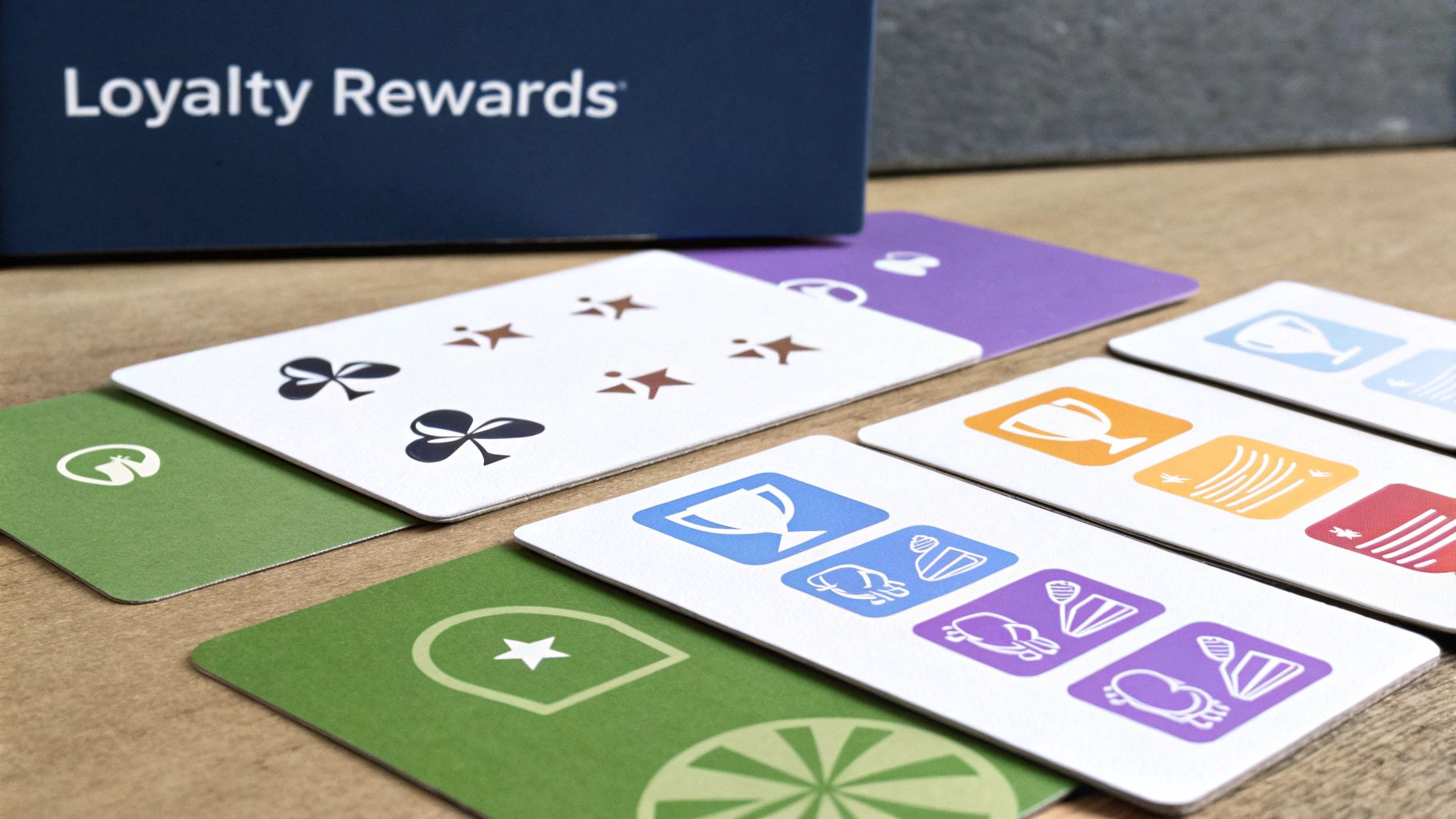
Let’s be honest. All the amazing strategies for boosting CLV—from white-glove onboarding to deep personalization—are incredibly powerful. But trying to manually execute them for every single customer is a fast track to burnout.
As you grow, personalizing every interaction by hand becomes completely impossible. This is where AI-driven automation stops being a "nice to have" and becomes the core engine of your growth.
Automation is what allows you to execute your best ideas at scale, consistently and without dropping the ball. It transforms your CLV strategy from a few well-managed accounts into a system that can nurture thousands of customers at once. The goal is to build an intelligent, automated framework that frees up your team from repetitive tasks so they can focus on what they do best: strategy and high-impact work.
Real-Time Segmentation and Personalization
One of the biggest wins with AI is its ability to segment customers based on what they're doing right now. Traditional segmentation is static, looking at demographics or old purchase data. AI is dynamic; it analyzes live behavioral data.
For example, an AI agent can see a customer has viewed your pricing page three times this week. It can automatically tag them as a "high-intent" lead in your CRM, which in turn could trigger a personalized email from a sales rep offering a quick demo. That's a level of responsiveness you simply can't achieve manually.
By using AI for dynamic segmentation, you're no longer reacting to what a customer did last month. You're engaging with them based on what they're doing in this moment, which makes every single interaction massively more relevant.
This completely changes the game, allowing for proactive engagement. Instead of waiting for a customer to complain, AI can spot signs of frustration—like multiple failed login attempts or repeated visits to the help center—and automatically create a support ticket before the customer even thinks to reach out.
Automating Proactive Support and Retention
AI automation can flip your customer support from a reactive cost center into a proactive retention machine.
Intelligent AI agents can handle the bulk of routine questions 24/7, giving instant answers to things like "Where's my order?" or "How do I reset my password?" This immediate support is a huge driver of customer satisfaction.
But the real magic happens when AI goes beyond simple Q&A. By connecting with your core business systems—your CRM, order management platform, and knowledge base—AI agents can perform complex, multi-step actions on their own.
Just imagine these scenarios:
- Automated Order Resolution: An AI chatbot on your site looks up a customer's order, sees it's delayed, and proactively offers them a discount code for their next purchase. No human needed.
- Proactive Churn Detection: An AI analyzes product usage and communication patterns to flag customers at risk of churning. It then automatically enrolls them in a targeted "win-back" campaign with helpful content or special offers.
This is exactly what platforms like FlowGent AI are built for. We connect all those separate systems to create seamless, intelligent workflows that make these scenarios a reality. Understanding the data from these automated interactions is crucial, and you can get up to speed with our guide on customer interaction analytics that actually work.
Ultimately, AI automation is how you truly scale your efforts to increase customer lifetime value. It ensures every customer gets a timely, personalized, and helpful experience, turning them into loyal, long-term advocates for your brand.
Common Questions About Increasing CLV
Diving into customer lifetime value can bring up a lot of questions. It’s one thing to understand the strategies, but it's a whole other ballgame to feel confident actually putting them into practice. Let's tackle some of the most common things people ask to clear things up and get you moving.
What Is a Good Customer Lifetime Value?
This is probably the number one question I hear, and the honest answer is: there's no magic number. What’s "good" is completely relative to your business. A SaaS company billing $200 a month will have a totally different target than an e-commerce shop where the average order is $45.
The real metric to watch is the relationship between your CLV and your Customer Acquisition Cost (CAC). You just need to make sure your CLV is significantly higher than what you spend to bring a customer in the door.
A healthy benchmark for a sustainable business is an LTV:CAC ratio of at least 3:1. For every dollar you spend getting a customer, you should be making at least three dollars back over their lifetime.
So instead of getting fixated on some universal number, focus on improving your CLV, month after month. That's the real sign of a healthy, growing business.
Which CLV Strategy Should I Start With?
It's easy to get analysis paralysis with all the options out there. My advice? Start at the very beginning of the customer journey: your onboarding process.
A fantastic first impression is everything for long-term retention. Think about it: a staggering 23% of customer churn happens just because of a clunky or confusing onboarding experience. If people don't "get" your value right away, they won't stick around for you to try any other fancy retention tricks on them.
Your main goal should be guiding new customers to an "early win"—that "aha!" moment where they truly feel the core benefit of what you offer. A solid onboarding process that nails this sets a positive tone for the entire relationship. It has a powerful ripple effect on every other CLV metric down the line.
How Can I Improve CLV Without a Big Budget?
Boosting CLV doesn't mean you have to empty your pockets. In fact, some of the most powerful strategies are low-cost and focus on building real relationships, not just throwing money at marketing campaigns.
Many of the highest-impact tactics are more about putting in the effort than spending cash. Here are a few ideas you can roll out with almost no financial investment:
- Personalized Thank-You Notes: A simple, automated email after a purchase that shows genuine appreciation can make a huge difference in how a customer feels about your brand.
- Actively Use Feedback: Sending simple surveys (like NPS) shows you care. But what really builds trust is when customers see you visibly acting on that feedback. That’s gold.
- Create Genuinely Helpful Content: Write blog posts, shoot short videos, or create guides that help customers get more out of your product. This turns you from a simple vendor into a trusted partner.
These small efforts cultivate loyalty by building a real emotional connection, proving you don't need a massive budget to make your customer lifetime value soar.
Ready to see how intelligent automation can supercharge your CLV strategies? FlowGent AI deploys smart AI agents that deliver personalized, 24/7 support across all your channels, turning every customer interaction into a loyalty-building opportunity. By leveraging advanced customer interaction analytics, you can maximize customer lifetime value and ensure every engagement drives deeper loyalty. Discover how FlowGent AI can help you scale.
